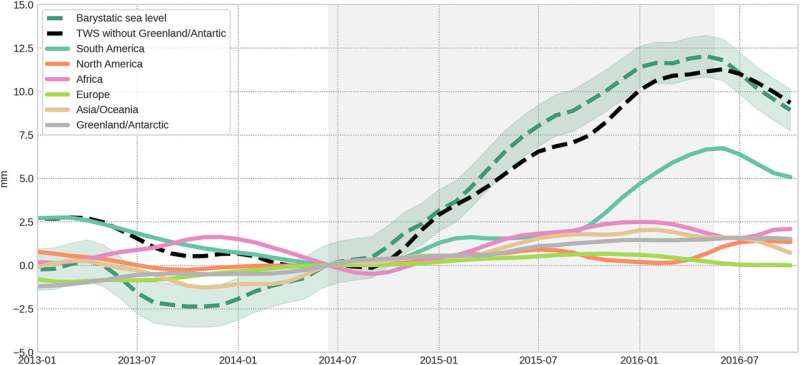
A group of oceanographers with Laboratoire d’Océanographie Physique et Spatiale, University Brest, CNRS, has found evidence that suggests an unexpected sea level rise over the years 2014 to 2016 was likely due to consecutive El Niño events.
In their study, reported in the journal Geophysical Research Letters, William Llovel, Kevin Balem, Soumaia Tajouri, and Antoine Hochet analyzed satellite and ocean sensor data to learn more about the events that led up to an unexpected rise in sea levels over the two-year period 2014 to 2016.
Prior research has shown that since 1993, the world’s oceans have risen by a little more than 9 centimeters. In studying sea level rise over that period, scientists found that it is due to climate change, which is causing ice at the poles to melt. They have also used data from the past and estimates of future climate change to make estimates about how much the world’s sea levels will rise in the future.
Such estimates have suggested that due to continued ice melting, the world’s oceans will rise by approximately 4 millimeters a year. But then something happened to cast such estimates in doubt. Over the two-year period 2014 to 2016, ocean levels rose at approximately double the expected rate—by 8 millimeters. After that, ocean levels went back to the previously estimated rate, suggesting that 2014 to 2016 was an anomaly. In this new effort, the research team set out to find out what had caused this huge, sudden increase in sea levels.
To learn more, the researchers undertook an exhaustive study of data for the years leading up to the anomaly, those during the sudden rise, and the years following. They looked at both satellite data and data obtained from sea sensors from around the world. They note that the data included ocean temperatures, ocean mass and the amount of water in watershed systems, such as the Amazon River basin.
The researchers found that the years 2014 to 2016 coincided with consecutive El Niño events. Both such events, they found, led to less rainfall on the Amazon basin, and more on the Pacific Ocean and large parts of Argentina. Most of the excess rainfall in Argentina ran off into the ocean. They conclude that it was likely the change in rainfall patterns due to the El Niño events that led to the sudden rise in sea levels over the years 2014 to 2016.
More information:
William Llovel et al, Cause of Substantial Global Mean Sea Level Rise Over 2014–2016, Geophysical Research Letters (2023). DOI: 10.1029/2023GL104709
Journal information:
Geophysical Research Letters
© 2023 Science X Network
Unexpected sea-level rise over 2014 to 2016 attributed to consecutive El Niño events (2023, October 30)
retrieved 31 October 2023
from https://phys.org/news/2023-10-unexpected-sea-level-attributed-consecutive-el.html
part may be reproduced without the written permission. The content is provided for information purposes only.